| Pages:
1
2 |
Pyrotrons
Harmless

Posts: 38
Registered: 13-10-2013
Member Is Offline
Mood: No Mood
|
|
I just got Pneumonia... Streptococcus... Are there any experiments I can do?!!
So I've felt like roadkill over the last few days. Mulling over all of my symptoms last night, I decided that after the next fit of coughing that I
would put a small amount of my light-green sputum on a microscope slide to further solidify my self-diagnosis of "Pneumonia". Under 800X what I saw
made my eyes pop out of my head. Thousands of highly motile organisms were immediately visible in the FOV. As I understand it, lungs are relatively
(not perfectly) sterile, so I got pretty worried. What I really wanted to do at that point was compare a healthy person's sputum with mine, but all
my friends were already wisely staying the fuck away.
I immediately went to a doctor, where he found a small but clearly visible, whitish colored, round shaped "dot" on my left tonsil. He determined that
Streptococcus was probably the bacterial type that was in my lungs, and prescribed me Azithromycin. I feel very fortunate to have this little white
spot giving me a sore throat.
What experiments can I do?!!! I have no experience whatsoever with microbiology. I mean none. But I've got damn good common sense and a decent 800X
uScope.
1. Is there any simple way for me to observe how well the Azithromycin works on my particular bacteria? Can I put 1mg of the Abx. into 100mL of
distilled water and "feed" it to my sputum or something? Horribly unscientific, I know, but I'm trying, and I'm excited.
2. I notice that when the tiny sample of sputum dries up on my microscope slide that all the bacteria stop moving. Are they dead for good? Is there
any way to bring them back? Can I deduce from this observation that any bacteria I leave behind in my room or my car will dry up and die forever,
ceasing to ever be a problem again?
3. Can I swab the white patch on my tonsil, and compare these bacteria with the ones that are in my lungs?? It's hard to make out shapes but I can
see motion well. I'm going to try this right now actually.
4. Disinfectants; I want to observe them work. I want to see what common disinfectants do to the microbes, perhaps in varying concentrations. Things
such as Ethyl and Isopropyl Alcohol, dish soap, or maybe just water of the wrong pH or temperature. I just don't know how to perform the observation,
for now I'll just directly apply chemicals to the microbes on the slide, and watch what happens...
I really am just wanting to experience microbiology in a hands-on way. Thanks in advance.
"Thus ethyl alcohol is inferior to xylene, although usable for certain applications." - Gerald Hurst
|
|
|
confused
Hazard to Others
  
Posts: 244
Registered: 17-3-2013
Location: Singapore
Member Is Offline
Mood: tired
|
|
1.you can culture them in petri dishes and use antibiotic infused disks to test
2. no, you have to use a disinfectant or autoclave it to ensure that its safe
3. that would work
4.i recommend you apply a bit at the edge of the slide and use your microscope to look the the interface where the two meet
Well, firstly i advise against doing cultures of pathogenic microbes (BSL-2/3)unless you know proper lab technique and know how to deal with a
biological spill, read and understand the WHO Biosafety manual.
but if you really must, setup a work area that can be easily sterilized, a metal/plastic surface that can be wiped down with 70% ethanol before and
after working with the samples.
Keep the work area away from any food preparation or serving area.
Do not use the antibiotics you are prescribed for experiments, finish them all, antibiotic resistance is becoming a real problem, if you must, try and
find antibiotics that are no longer used (pennicillin .etc), you might be able to find some fish antibiotics.
General rule of thumb, everything that touches any culture/sample must be sterilized/disinfected and disposed of correctly, don't just dump it down
the sink.
Get some petri dishes and make/buy some nutrient agar to culture the bacteria, Carolina biological supply have some great stuff, including some
strains of non pathogenic microbes you should start with, but in a pinch, some shallow jars could work as petri dishes and pressure cookers can work
as autoclaves, if needed.
http://www.who.int/csr/resources/publications/biosafety/WHO_...
http://www.sciencestuff.com/nav/instructions/agar1.htm
http://www.science-projects.com/PlatesSelfMade.htm
http://microbiologyon-line.blogspot.com/2009/08/autoclaving-...
http://www.cdc.gov/hicpac/disinfection_sterilization/6_0disi...
|
|
|
Tsjerk
International Hazard
    
Posts: 3032
Registered: 20-4-2005
Location: Netherlands
Member Is Offline
Mood: Mood
|
|
A couple of weeks ago I was at a lecture about bacterial resistance, and I was told the only known bacterial family known not to have gained
resistance is the streptococcus family! So even penicillin should be effective against it!
Very interesting to test this, what country are you from? If you can get penicillin, try to get agarose (preferably) or gelatin and make a gel in
which you can include the antibiotic (don't forget the negative control).
Do not add the antibiotics when the gel is still hot (100 degrees Celcius) but only when it has cooled enough so you can hold it for at least 5
seconds with bare hands, otherwise the antibiotics will degrade.
"streak" your bacteria on the gel and incubate overnight at 37 degrees.
If you need some time before starting the experiments store your bacteria at 4 degrees Celcius.
Do you really see your bacteria swim or just moving? If the latter, it is just Brownian motion. If the first, it is not streptococcus, the are
immobile, as all coccus species.
Edit: To answer your question two; no, they are not dead, the just seem to stop moving because the are "fixed", the movement brownian motion, if the
water evaporates the will stop moving.
An experiment was ones done with a bacterial species that was unable to form spores, and was shaked at 37 degrees without adding new nutrients. They
kept viable for over a year, the experiment was unfortunately forced to stop as an fungal infection was caught during one of the tests for viability.
Edit 2: I wouldn't worry to much about your samples gaining resistance. Over the last 60 years there has been a far greater selection pressure on
bacteria in general than you can replicate in a one time experiment. Just be sure to add some bleach at to your samples when done and incubate
overnight before flushing them through the drain. Do complete your antibiotic medication though for your own sake.
[Edited on 18-12-2013 by Tsjerk]
[Edited on 18-12-2013 by Tsjerk]
|
|
|
phlogiston
International Hazard
    
Posts: 1379
Registered: 26-4-2008
Location: Neon Thorium Erbium Lanthanum Neodymium Sulphur
Member Is Offline
Mood: pyrophoric
|
|
For consistent results in your experiments, you will want to isolate a pure strain first, i.e. from the mixture of bacteria that you inevitably get
from your sputum/any other source, you will need to isolate one single bacterium and culture that.
If you don't you are going to get competition between the different microorganisms in your cultures and you may end up experimenting with a culture
that is predominantly something else after a while.
To do this, first make nutrient plates (without antibiotic at first) as Tsjerk describes, and using a sterile loop of metal wire (hold it in a flame
for a few seconds), take a very tiny amount of your sample (just touching the sample with the loop is enough to pick up some bacteria) and spread it
on your nutrient plate. Then incubate for some time in a warm humid place. You will see spots appear on the plate over the course of a day if the
conditions are favourable (see image below). These are colonies that each have grown from a single microorganism. Select one of these colonies and
transfer to a fresh nutrient plate, spread it out a little and allow to grow again.
If you want to do it very properly, repeat it a couple of times, each time pick a round colony that is clearly separated from nearby colonies.
example:

[Edited on 18-12-2013 by phlogiston]
-----
"If a rocket goes up, who cares where it comes down, that's not my concern said Wernher von Braun" - Tom Lehrer |
|
|
Bot0nist
International Hazard
    
Posts: 1559
Registered: 15-2-2011
Location: Right behind you.
Member Is Offline
Mood: Streching my cotyledons.
|
|
Its funny this is brought up, as I recently had a staff infection in my fingertip from running a paint chip under my nail. It wasnt reponding to the
common antibiotics, so they cultured it and claimed it MRSA. It finally healed after two seperate occasions of it being cut at and drained, and weeks
of pain with intermittent high fever along with a regime of three antibiotics including the costly "augmentin" knock offs with the added clavulanic
acid salt to prevent the bacterium's enzymes from cleaving and destroying the beta-lactam antibiotics I guess. My understanding is quite basic though.
I breifly thought about preparing a culture of it, as I have many of the needed supplies from my mycology ventures. In the end rationality prevailed.
I didnt want to risk my family or others being exposed, or have it around at all one my poor finger tip healed. Not to mention what kind of trumped up
charges I could have gotten, cultivation what could be construed as a bioweapons material by the right people, im sure. I have pictures of my finger
progressing if anyone is interested. They are not for the faint of heart though. A fingertip infection is known as a felon, and a nail/cutical
infection known as a paranychial (im sure I spelled that wrong). It really did hurt like hell though. Anyways, sorry for derailing.
[Edited on 19-12-2013 by Bot0nist]
[Edited on 19-12-2013 by Bot0nist]
U.T.F.S.E. and learn the joys of autodidacticism!
Don't judge each day only by the harvest you reap, but also by the seeds you sow.
|
|
|
bfesser
Resident Wikipedian
    
Posts: 2114
Registered: 29-1-2008
Member Is Offline
Mood: No Mood
|
|
Sure; why the hell not? Post
them—<em>for science!</em>
|
|
|
Pyrotrons
Harmless

Posts: 38
Registered: 13-10-2013
Member Is Offline
Mood: No Mood
|
|
Ohh, this is going to be fun. Thanks for the recommended experiments. (And omg, I just realized Hobby Lobby has Agar and petri dishes...where are my
keys).
tsjerk - Answering your questions:
> Do you really see your bacteria swim or just moving? If the latter,
> it is just Brownian motion. If the first, it is not streptococcus, the
> are immobile, as all coccus species.
Several different kinds as far as I can tell, most of which are extremely active. I mean like bouncing off the fucking walls randomly in all
directions - some of them bending in half to do it. I find the motion mesmerizing - this is exactly what I think of when I hear the word
"biological". And I found my immersion oil, I'm seeing clearly at 2000X now for the record. I am in the USA. Thanks for your input.
Bot0nist, Staphylococcus - Staph. Please do post the pictures!
I believe I had this one time... accidentally sliced the webbing of skin between my forefinger and thumb with a piece of 100 grit sandpaper (paper cut
x 10). NOT pleasant. Anyhow... after the cut, with all my intelligence I was off to the TIG welder, and slid those nasty ass fucking gloves on
without thinking. 5 days later I'm 60 feet up in the ceiling of a museum installing equipment, but rendered ENTIRELY useless by pain from an
intensely throbbing, inflamed, pink, and red-streaked left hand. Scary.
On goes some 70% EtOH on a razor blade, then I dug into it a bit (couldn't stomach a slice), and squeezed it as hard as I could with my other hand.
It hurt so bad I saw stars and almost passed out. Some white shit came out.
Hand was perfectly normal again in 48 hours.
[Edited on 19-12-2013 by Pyrotrons]
[Edited on 19-12-2013 by Pyrotrons]
[Edited on 19-12-2013 by Pyrotrons]
"Thus ethyl alcohol is inferior to xylene, although usable for certain applications." - Gerald Hurst
|
|
|
Bot0nist
International Hazard
    
Posts: 1559
Registered: 15-2-2011
Location: Right behind you.
Member Is Offline
Mood: Streching my cotyledons.
|
|
Will do. Have to download a pic editer on this phone to resize them.
U.T.F.S.E. and learn the joys of autodidacticism!
Don't judge each day only by the harvest you reap, but also by the seeds you sow.
|
|
|
Bot0nist
International Hazard
    
Posts: 1559
Registered: 15-2-2011
Location: Right behind you.
Member Is Offline
Mood: Streching my cotyledons.
|
|
MRSA (Staphylococcus aureus) Infected fingertip.
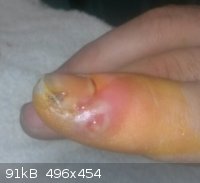
The blackish spot is the entry wound from the paint chip. At this point, the pain was unbearable and every time my heart beat, it could be seen in the
coloration under the nail along with a throbbing sensation. About 8-9 days from first injury. Running a fever at this point.and on amoxicillin for 3
days.
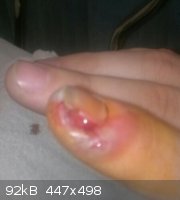
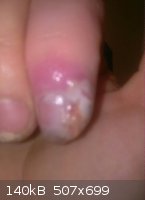
My doctor removed a quarter of the nail, and the necrotic tissue and pus from underneath it. She used little scossors, and a lot of squeezing. It
hurt.]
[Edited on 21-12-2013 by Bot0nist]
U.T.F.S.E. and learn the joys of autodidacticism!
Don't judge each day only by the harvest you reap, but also by the seeds you sow.
|
|
|
SM2
Hazard to Others
  
Posts: 359
Registered: 8-5-2012
Location: the Irish Springs
Member Is Offline
Mood: Affect
|
|
That's what I was going to say, Agar - plate it out. There are so many interesting microorganisms out there, all one has to do is to plate out
samples from air, soil, a field of rye, for instance, and eventually you get the pure culture you are looking for. Then you can grow/ferment vast
quantities of the bacteria or fungus that you need.
"Old men who speak of victory
shed light upon their stolen life
they - drive by night- and act as if they're
moved by unheard music." B. Currie
|
|
|
Bot0nist
International Hazard
    
Posts: 1559
Registered: 15-2-2011
Location: Right behind you.
Member Is Offline
Mood: Streching my cotyledons.
|
|
After 3 days of the strong antibiotics it was getting bette. r.
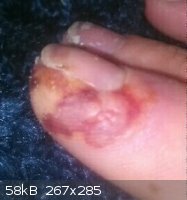
The dead skin fell off a few days later.
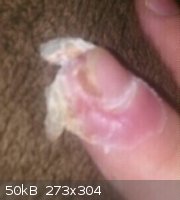
And now it almost back to normal. Still a bit tender though. This whole experience really put the fear in me about minor injuries amd how bad they
could get. When my doctor started talking about future amputations i was terrified and shocked.. From a chip under my nail. Something that has
happened a hundred times in my life.
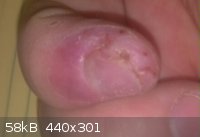
U.T.F.S.E. and learn the joys of autodidacticism!
Don't judge each day only by the harvest you reap, but also by the seeds you sow.
|
|
|
Pyrotrons
Harmless

Posts: 38
Registered: 13-10-2013
Member Is Offline
Mood: No Mood
|
|
Thanks for the pictures Bot0nist, that's pretty horrible.
Well I've constructed myself an incubator. The enclosure is a foam cooler from a local gas station...$7.00 for $0.10 of styrofoam. Anyhow, I got
some expanded metal/wire rack material from the hardware store and bent it to make a "rack" in the middle to place the Petri dishes. I made some Agar
solution (boy do I hate seeing things like "Tbsp." and "Tsp." on "Instructions".... leave that shit in the kitchen where the cookies don't come out
the same every time huh?). But I've got to give it to Hobby Lobby; they actually had the Agar, so, whatever!
I grabbed a couple of 500-ohm resistors from work and bolted them to a heatsink. Dropped the heatsink down in the cooler along with a 120V fan... and
I made what is basically a Solid-State Relay out of a single MOSFET. I have an Arduino regulating the temperature of everything now... 37 degrees C
to be exact (recommendation from Tsjerk).
At first the incubator didn't work, I was underestimating how good of an insulating box a simple cooler is. The fan itself... was creating enough
heat to go 10 degrees above my setpoint. So I had to replace the lid with a piece of plastic, and even then I had to leave a 2-cm gap at the top...a
"calibrated leak"...to let some hot air out and keep things in regulation.
I made an innoculating loop from a piece of 60/40 Sn/Pb solder. After watching the rosin flux ball up on the end I figured that was a stupid idea...
so I switched to some Sn-plated Cu wire. I sterilized between streakings with 70% EtOH and a 500 Deg. C surface to dry the EtOH. If I had had a
torch I would have just done that... but I didn't.
So my first Petri dishes, and streakings, are now made. I was careful with sterile technique, counting a lot on 70% EtOH.
I do feel like a bit of a mad scientist... I can't wait to see what grows...
Update on my condition, the Azithromycin doesn't seem to have touched the small colony of white bacteria on my left tonsil. In fact, the colony has
grown a small amount. I am continuously hypoxic...almost euphoric. My thumbnails have not regained their normal pink color, they are still
significantly white in the middle. The coughing has eased up a lot.
Quote from Tsjerk:
| Quote: | | ...and I was told the only known bacterial family known not to have gained resistance is the streptococcus family! So even penicillin should be
effective against it! |
This makes me wonder if this is really Streptococcus on my left tonsil then...
I cultured the hell out of it. Something should grow. Then I will isolate a couple/few times and test resistance to...hmm what do I have here...
Ciprofloxacin (Cipro) that I never took when I was in Mexico City, and Amoxycillin...
Just so everyone knows, I have lots of bleach on hand, when I'm finished I will be boiling the cultures in it.
WELLLLL............. I just took a peek inside the incubator, all the Agar in four Petri dishes is MELTED back to liquid.........
Fucking tablespoons, teaspoons....and volumetric measurements where it should be gravimetric. This sucks. I'll have to find a real procedure for
making an Agar solution online somewhere.
[Edited on 25-12-2013 by Pyrotrons]
"Thus ethyl alcohol is inferior to xylene, although usable for certain applications." - Gerald Hurst
|
|
|
confused
Hazard to Others
  
Posts: 244
Registered: 17-3-2013
Location: Singapore
Member Is Offline
Mood: tired
|
|
that probably means the temperature in your incubator is too high, for Streptococcus it should be arround 37'C
|
|
|
Pyrotrons
Harmless

Posts: 38
Registered: 13-10-2013
Member Is Offline
Mood: No Mood
|
|
confused, thanks but 37 degrees has already been mentioned. Twice.
Does anyone have any advice on how to get the Agar product from Hobby Lobby to work, at temperatures higher than room temp?
I will start by doubling the amount of Agar, while keeping the concentration of Sucrose and water the same.
I notice that their little bags of Agar are all labeled "3g". There are actually 7 grams of Agar in each bag 
EDIT: Instead of doubling the amount of Agar, I think I will just try to duplicate this company's concentrations:
http://www.bio-rad.com/webroot/web/pdf/lse/literature/Bullet...
From what I gather, they are using 35g Agar, 10g Sugar, and 1L water. This implies an Agar concentration of 3.5%, Sugar: 1%.
Something tells me this isn't going to work. If my original 10% Agar solution melted, why would a 3.5% solution not?
But I have to try. Good thing I bought every Agar packet they had.
[Edited on 25-12-2013 by Pyrotrons]
"Thus ethyl alcohol is inferior to xylene, although usable for certain applications." - Gerald Hurst
|
|
|
Pyrotrons
Harmless

Posts: 38
Registered: 13-10-2013
Member Is Offline
Mood: No Mood
|
|
As expected, it did not work. The agar is melting back to liquid state before it reaches 37 Deg. C.
Scrapping all this crap from Hobby Lobby, I'm headed to the store (seriously doubt they're open...Christmas day...) to get things to make my own agar.
Hopefully with results that approximate...agar.

"Thus ethyl alcohol is inferior to xylene, although usable for certain applications." - Gerald Hurst
|
|
|
confused
Hazard to Others
  
Posts: 244
Registered: 17-3-2013
Location: Singapore
Member Is Offline
Mood: tired
|
|
my bad 
you might want to try
3.2g agar powder per 100ml deionized water
got that from one of my old lab manuals
it says nutrient agar, but it shouldn't be all that different from agar powder
[Edited on 25-12-2013 by confused]
|
|
|
Etaoin Shrdlu
National Hazard
   
Posts: 724
Registered: 25-12-2013
Location: Wisconsin
Member Is Offline
Mood: Insufferable
|
|
If you got the Hobby Lobby kit I'm thinking of, the instructions are mind-bogglingly terrible. Do they give vague amounts for the water, aka "not that
much, about X" and so on? I'm sorry it didn't work out.
You could try isolating a pure strain (or several) on regular nutrient agar, then once you have the cultures going try to grow them on selective
agars, or with different antibiotics to see the results. Maybe try exposing samples to different household cleaning chemicals for a certain length of
time, then try to culture again and see whether they still grow.
Gram staining would be a good first step in classifying what you isolate.
|
|
|
confused
Hazard to Others
  
Posts: 244
Registered: 17-3-2013
Location: Singapore
Member Is Offline
Mood: tired
|
|
Gram staining would be good, but the counterstain, safranin is somewhat hard to get get, you could try methylene blue and gentian violet, although its
hard to make out the gram positive and negative bacteria due to the colours of the stains
methylene blue-blue
gentian violet-purple
[Edited on 27-12-2013 by confused]
|
|
|
Etaoin Shrdlu
National Hazard
   
Posts: 724
Registered: 25-12-2013
Location: Wisconsin
Member Is Offline
Mood: Insufferable
|
|
That depends where you look. I'm assuming the OP is in the US due to the mention of Hobby Lobby but it's possible I'm mistaken. I've never had trouble finding it myself
(though I haven't used it in years, either).
|
|
|
Pyrotrons
Harmless

Posts: 38
Registered: 13-10-2013
Member Is Offline
Mood: No Mood
|
|
LOL, Etaoin Shrdlu, you actually put each link in each separate word. Genius!!!
And you are correct, the instructions are indeed mind-bogglingly terrible. How about : "Boil water (not that much, maybe 1/2 cup). And "Tablespoon"
and "teaspoon" and "cup" and "goopy and thick".
I am in the US, but I take no accountability for the crap that's on the shelves here.
Another failed experiment of mine, is homemade agar, using beef bouillon and gelatin. Not only did the fat from the beef square precipitate out of
solution when it cooled... you guessed it... it melted before 37 degrees C again.
I'm either buying commercial Agar or I'm throwing the entire idea away. Though having said that, your links to the gram-staining kits are
tantalizingly cool...
"Thus ethyl alcohol is inferior to xylene, although usable for certain applications." - Gerald Hurst
|
|
|
confused
Hazard to Others
  
Posts: 244
Registered: 17-3-2013
Location: Singapore
Member Is Offline
Mood: tired
|
|
geletin will melt as its gelling temperature is close to its melting temperature also, some microorganisms can digest geletin as a protein source thus
its not commonly used as a growth medium
Carolina biological supply has a good supply of growth medium and sells to individuals
|
|
|
Pyrotrons
Harmless

Posts: 38
Registered: 13-10-2013
Member Is Offline
Mood: No Mood
|
|
I usually don't take "no" for an answer, guess I didn't this time.
Just spent $100 at "Home Science Tools"... the first of your links, Etaoin Shrdlu. Got 5 nice 100mm glass petri dishes, the gram stain kit, 8g
dehydrated nutrient agar, and even baby's first innoculating loop : )
As well as a 100mL volumetric flask, their 60-piece rubber stopper kit, spare thermometer, and other things I really don't need that much...
confused...seriously man, I just took a look at every one of your posts...it seems to me that you're just endlessly spewing stuff pal... to the point
where you literally explained that blue = blue and violet = purple. And every single one of the other guy's links has shit in stock sells to
individuals...not just the one you mentioned.
Here's how you can help.
Tell me, that the nutrient Agar that I just bought will hold up and not melt at temperatures less than 37 degrees C.
[Edited on 27-12-2013 by Pyrotrons]
"Thus ethyl alcohol is inferior to xylene, although usable for certain applications." - Gerald Hurst
|
|
|
confused
Hazard to Others
  
Posts: 244
Registered: 17-3-2013
Location: Singapore
Member Is Offline
Mood: tired
|
|
you should sterilise your agar before pouring out the plates, you should boil it for 1/2 hour or autoclave it in a pressure cooker type vessel
|
|
|
Etaoin Shrdlu
National Hazard
   
Posts: 724
Registered: 25-12-2013
Location: Wisconsin
Member Is Offline
Mood: Insufferable
|
|
It''s probably just a difference in location. Safranin might be hard to get in Singapore.
Gelatin will melt at a pretty low point, unfortunately. I think it's around normal body temperature. Plus confused is right, agar's better as it
doesn't get broken down by bacteria. This is Sigma-Aldrich's agar tech data sheet. It looks like regular agar gel will melt somewhere around 87 °C. I like their microwave method.
I'm surprised the stuff from Hobby Lobby didn't work now. If it's anything like typical nutrient agar it should be at least half agar, so the 3.5%
concentration should have been at least 1.7% agar which should have gelled up nicely and stayed that way. Gels for electrophoresis tend to be 1% and
those are still firm. I wonder if it was actually gelatin or something else. -headscratch-
Wishing for my old pressure cooker at the moment. I never thought of using it as an autoclave. I know it wouldn't be a perfect substitute but that's
still a fantastic idea.
|
|
|
confused
Hazard to Others
  
Posts: 244
Registered: 17-3-2013
Location: Singapore
Member Is Offline
Mood: tired
|
|
Everything is hard to get in Singapore 
well, as long as it can maintain 121'c at 15 psi for about 15 minutes it should work as well as a commercial autoclave.
my pressure cooker works well enough that it changes the colour on autoclave tape
also would microwaving the agar to melt it work to sterilize it as well?
[Edited on 27-12-2013 by confused]
|
|
|
| Pages:
1
2 |